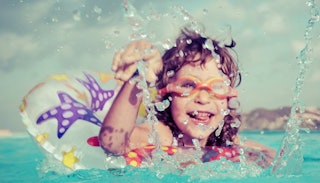The Scary Truth About Drowning

Ahhhhh, the lazy days of summer. Relaxing by the pool, without a care in the world, as you soak up the sun’s rays and thank the universe that the endless winter is finally long gone.
Oh, wait; you’re a parent, right? Then you know that your days of equating water with relaxation are OVER.
RELATED: The Best Above-Ground Pool Ladders For Safety And Accessibility
They should be, at least. Because it’s one thing to be the chill parent at the playground or ignore your kids under the safety of your own roof, but at the pool? Go ahead and put your Helicopter Mom hat on. Please.
According to the CDC…
• Among one to four year olds, drowning is the second leading cause of death, just behind car accidents.
• An average of ten people a day die of drowning. Of those ten, two are children under the age of 14.
• Of the approximately 750 children who will drown next year, about 375 of them will do so within 25 yards of a parent or other adult.
How is that last fact even possible? Because, it turns out, the vision of drowning that we’re on alert for — flailing arms, calling out for help — is the exact opposite of what drowning really looks like. Last year, Slate ran a piece by Mario Vittone about the instinctive drowning response which is worth a read. It explained that:
• Drowning people are almost always unable to call out for help.
• Drowning people cannot wave for help. Nature instinctively forces them to extend their arms laterally and press down on the water’s surface.
• Unless rescued by a trained lifeguard, drowning people can only struggle on the surface of the water from 20 to 60 seconds before submersion occurs.
So what does drowning look like? Vittone says to be on the lookout for the following behavior in the water:
• Head low in the water, mouth at water level
• Head tilted back with mouth open • Eyes glassy and empty, unable to focus • Eyes closed • Hair over forehead or eyes • Not using legs; in a vertical position • Hyperventilating or gasping • Trying to swim in a particular direction but not making headway • Trying to roll over on the back • Appear to be climbing an invisible ladder
Unfortunately, the danger of drowning isn’t over once a child is outside of the water. Something called “secondary drowning” can occur when a small amount of the water gets into the lung, and might not be apparent until hours after the initial incident. (Read one mom’s story here.) If, after swallowing too much water, your child continues to cough, has trouble breathing, or isn’t acting like himself, it’s time to head to the ER.
Scary? Yes, it’s all terrifying, but in this case, ignorance isn’t bliss. Let’s keep our kids safe this summer, so we can all rejoice together when they head back to school in the fall. Deal?
This article was originally published on